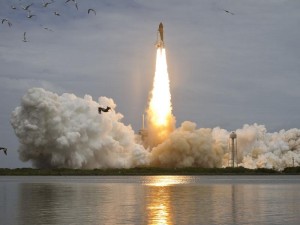Amgen, NASA partner to conduct R&D aboard space shuttle Atlantis

When space shuttle Atlantis took off on its final mission Friday, it was carrying a crew of special tiny passengers that are part of an advanced research and development project that could benefit humans for decades to come.
For the mission, pharmaceutical giant Amgen teamed up with the National Aeronautics and Space Administration Ames Research Center to conduct a preclinical test of an antibody called sclerostin, that could counter the effects of bone loss associated with space flight.
Aboard the aircraft are 30 mice, half of which will be given the sclerostin antibody to test if it inhibits the action of a namesake protein that sets back bone formation, bone mass, and bone strength. After the flight, various aspects of the structure, composition, strength, and cell and molecular nature of the bones from the flight and ground-based control mice will be analyzed.
Space shuttle Atlantis is slated to come back to Earth July 20, marking the end of the program’s three-decade run.
The findings of the experiment aboard Atlantis may also provide insight into potential further research in the prevention and treatment of the skeletal fragility that can result from “skeletal disuse” in such conditions as immobilization, stroke, cerebral palsy, muscular dystrophy, spinal cord injury, and reduced physical activity.
“It is an honor to work with NASA on this historic final mission,” said Chris Paszty, Ph.D., scientific executive director at Thousand Oaks, CA-based Amgen. “This proof of principle study will enhance our understanding of the science behind the sclerostin antibody and arm us with important research to support potential future therapeutic applications in both astronauts and patients suffering from bone loss.”
For the R&D project, Amgen is collaborating with another global pharmaceutical company, UCB, according to information posted on the company’s website.
“We are very excited to be working on this momentous experiment. It will help us to better understand the sclerostin antibody,” said Prof. Iris Loew-Friedrich, chief medical officer and executive vice president of Global Projects and Development at UCB. “The origin of UCB’s sclerostin program was the discovery of the genetic cause of a rare inherited high bone mass condition. This fascinating approach of turning genetic discovery into novel and innovative drug development seems fitting to the collaboration with NASA whose mission is exploration and discovery.”
Amgen, which has been operating in Juncos for nearly 30 years, pumped $2.9 billion into R&D projects in 2010.











